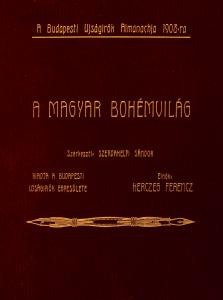
The Hungarian Bohemian World. Almanac of the Budapest Journalists’ Association 1908
A Magyar Bohémvilág. A Budapesti Újságírók Almanachja 1908-ra (The Hungarian Bohemian World. Almanac of the Budapest Journalists’ Association 1908)
Facsimile edition
Accompanying studies written by Zoltán Szénási and András Wirágh NSZL–Argumentum, Budapest, 2019, 592 pages
ISSN 0201-2510 01908
The year 1907, the chronicle of which is given in the volume, was characterized by calm times, less tumultuous events, but it can still be exciting for the reader today, who can read this collection knowing that these events and thoughts preceded the turning point in literary history that occurred in1908.
This year was entitled A magyar bohémvilág (The Hungarian Bohemian World), with the subtitle Irókról, újságirókról, szinészekről, poétákról, zenészekről, festőkről, szobrászokról, stb. (About Writers, Journalists, Actors, Poets, Musicians, Painters, Sculptors, etc.). True to its title, the Almanac introduces the reader through thematic sections to journalism and the life of journalists, and presents even behind the scenes of the art world with the help of renowned figures from contemporary newspaper literature. In some places, the texts reveal the club life of journalists, the difficulties associated with editorial tasks, or the relationship between the press and the readership in a humorous or informative way, while these newspaper publish writings by Endre Ady, Géza Gárdonyi, Margit Kaffka, Dezső Kosztolányi, Ferenc Molnár or Szép Ernő.
The Almanacs of Budapest Journalists are invaluable repositories for today’s researchers about the writers’ and journalists’ society and its operation at the turn of the century. With the republishing of these, the National Széchényi Library and Argumentum Publisher intend to contribute primarily to the research of the history of society, press and literature at the beginning of the 20th century, but we hope that the volume will be of interest to the ‘educated readership’. The study of Zoltán Szénási examines the history of the series in its entirety, and András Wirágh provides information about the thematic yearbook of 1907.
Shopping
Our publications are available in our bookshop, or can be ordered from the Publications Department of the NSZL using the contact details below: Főigazgatói Kabinet kiadványtára, Országos Széchényi Könyvtár, 1276 Budapest P.O. box 1205., phone: 06-1-23-23-506, e-mail: kiadvanytar@oszk.hu.




